Disclaimer: EcoFlow sent this product to us for free for a review. That does not affect our opinion about the product. In this article, we list both what we like and dislike. Read more about this here.
Is The River 2 Max The Ultimate Mid-Size Power Station?
The River 2 Max is one of EcoFlow’s latest portable power stations, and I have to say I was initially very impressed when I saw the specs.
100W USB C PD port, LiFePO4 batteries, WiFi/Bluetooth-support, four AC ports, fast charging, and the 1000W X-boost were some features that made me say yes when EcoFlow asked if I would like to review it.
I have had the River 2 Max for a couple of weeks and I feel like I know it well enough to share my thoughts on it.
I have a lot of good things to say about it, and by the end of this review I hope you feel you know the pros and cons of this product.
I’m going to start like I usually do by going over the features, before I list my opinions.
Features
Battery Capacity
The River 2 Max is rated at 512Wh (watt-hours).
To give you a rough estimate: A 512Wh battery will power a 50W device for almost 9 hours with a 85% inverter efficiency (512Wh/50W*0.85=8.7).
The battery chemistry used is LiFePO4 (LFP). These types of batteries are rated for up to 3000 cycles before reaching 80% capacity.
Inverter
An inverter changes the DC battery power to AC power, to make it possible to power and charge devices via a regular AC outlet, just like the ones in your home.
Usually, they’re not as powerful as a household outlet though in terms of how many watts it can output continuously.
The pure sine wave inverter used in the River 2 Max is rated for up to 500W output, but with EcoFlow’s X-boost features it can output up to 1000W with certain devices.
Ports
There are four AC outlets (two 3-prong and two 2-prong).
One regulated 12V cigarette port, and two 5.5mm DC outputs.
Three USB A ports rated at up to 12W each, and one USB C PD port rated at 100W input/output.
The USB C PD port can be used to either charge the EcoFlow battery, or charge compatible devices like phones, tablets, laptops, etc.

Display
The display on the front tells the battery percentage, input/output watts, time to empty/full, active ports, and different warnings.
Charging
With the included AC wall charger, the River 2 Max can be fully recharged in 1 hour. It takes a little over 5 hours with the included car charger.
If you would rather charge the battery with solar panels, the MPPT charge controller can handle voltages between 11 and 50, 13A, up to 200W max.
By maxing out the solar input, you can fully recharge it in about three hours.
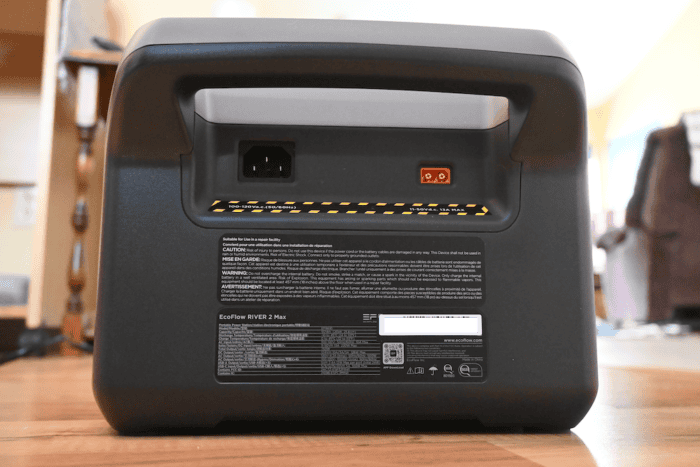
WiFi/Bluetooth
The built-in WiFi and Bluetooth makes it possible to control and monitor the power station even if you’re not near it.
Connect it to an existing WiFi-network, and you can be in full control of it even if you’re on the other side of the world.
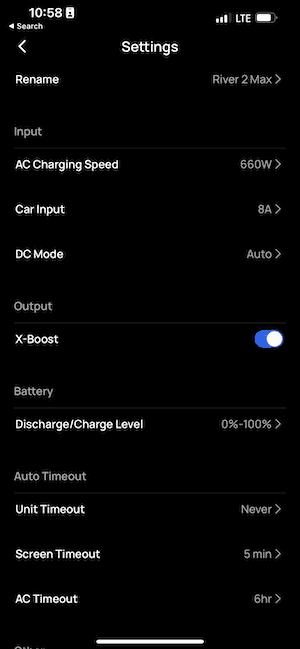
In the app you can change the charging speeds, turn on/off X-boost, change unit/screen/ac timeouts, and set the discharge level.
Of course, you can also monitor the input/output watts, turn on/off ports, and update the firmware.
UPS
UPS stands for Uninterrupted Power Supply. It’s a way to make sure that your devices stay on even during a power outage.
The River 2 Max has a built-in UPS feature, so you can leave the AC wall charger plugged in to the power station, then plug your devices that you want to stay on into one of the AC outlets on the River 2 Max.
If the power goes out, the power station will quickly switch over to using battery power instead.
Size & Weight
The River 2 Max weighs 13.4 pounds and measures 10.6 by 10.2 by 7.7 inches.
A built-in handle on the back makes it easy to carry and transport the power station.
In The Box
EcoFlow includes an AC charging cable, a car charging cable, and a 5.5mm cable for the DC output.
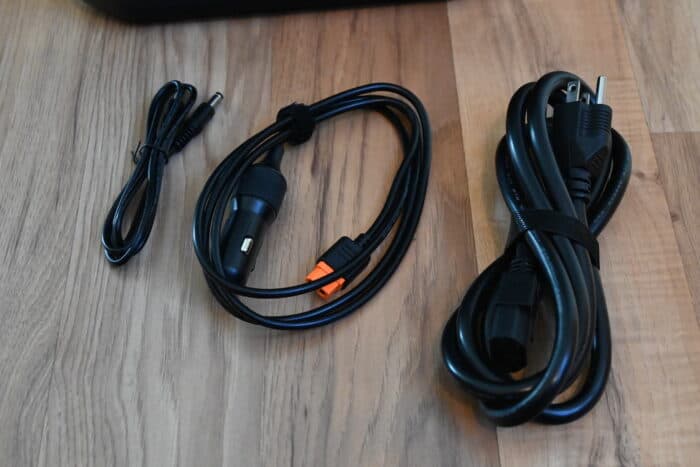
My Review
What I Like
USB C PD is both for charging and discharging
The USB C PD port on the front can be both as an input and output, and I like that a lot.
Being able to charge the power station with a USB C PD wall charger is very useful, since it means I don’t have to carry the wall charger cable with me if I have limited space.
I always have a 100W USB C PD wall charger with me since it’s what my laptop charges with, and I can use that to charge the EcoFlow as well.
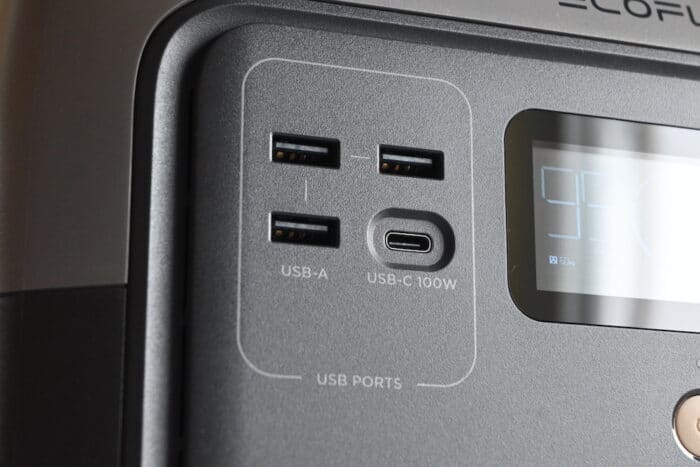
WiFi/Bluetooth support
I have connected other EcoFlow power stations to WiFi and Bluetooth before, but something has been upgraded with the River 2 Max.
It’s an instant connection, I didn’t even have to pair it with Bluetooth the first time. It just showed up in the app.
Even if I don’t open the app for a day, the second I open it up it’s connected.
I was very impressed by this, and I am sure this is something all new EcoFlow power stations will get.
LiFePO4 batteries
The LiFEPO4 batteries last a lot longer than the more typical Li-Ion batteries used in most power stations.
Longer as in being able to go through more cycles before losing the same amount of total capacity.
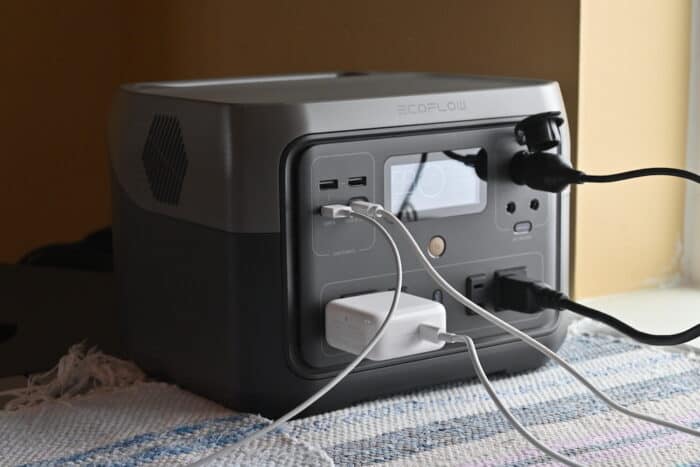
3000 cycles to 80% capacity is great, and means that you could go through a cycle everyday for more than 8 years before getting down to 80% total capacity.
Some of the most popular power stations out there can only go through 500 cycles before reaching the same capacity.
In my opinion, this is one of the most important features for sustainability reasons.
UPS
The UPS function works, and it’s nice to have.
I can see myself using this with something like my router in my house, that I want to make sure stays on during power outages.
Fast charging
EcoFlow has always shined with fast charging capabilities, and the River 2 Max is no different.
Even though it uses LiFePO4 batteries, it supports quick-charging.
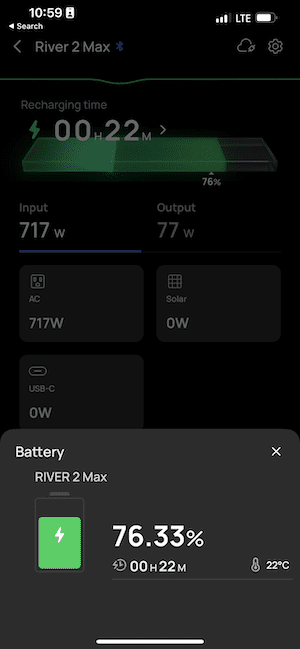
The River 2 Max can be fully charged within 1 hour, but you can change the charging speed in the phone app if you would like.
Lightweight for what you get
LifePO4 batteries are heavier than Li-Ion, yet the River 2 Max is lighter than some of its closest competitors that use Li-Ion.
I don’t know exactly how EcoFlow did it, but it’s impressive.
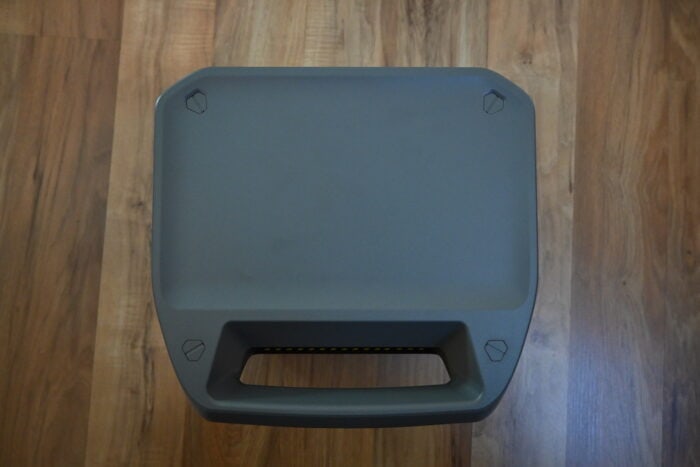
What I Dislike
No MC4 to XT60 adapter included
EcoFlow used to include MC4 to XT60 adapters, now they’re included with EcoFlow solar panels instead.
I understand the reason behind this, but I sure wish one was still included with the power stations.
Conclusion
Even though I have only had the River 2 Max for a couple of weeks, I must say it’s one of my favorite power stations this year.
It has almost every feature that I want to see in a portable power station of this size.
I do wish it included an MC4 to XT60 adapter, and that it had a wireless charging pad on top, but other than that it’s an extremely well-made power station that can do what it says it can.
The question is, how is EcoFlow going to upgrade this further? Expandability, a more powerful charge controller, more ports? I don’t know, but I am excited to see what comes next.
Please leave a comment down below if you have any questions.


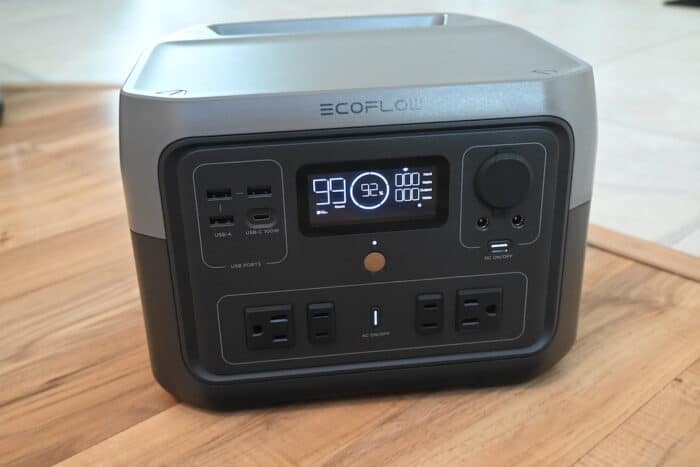
hello! I bought the engel mr040 compressor fridge that consumes 32 w. I am going very little by little with the transformation of the van, the truth is, and it is crazy because new products come out every so often, I was thinking of buying the River 2 pro now but there is still no possibility of acquiring it in Spain. I would like you to give me your opinion on this configuration to feed the Engel refrigerator. Would a River 2 Max with two flexible 100w ecoflow panels be enough?
Hi,
It’s hard to say, I haven’t tested the Engel fridge but that does sound like a efficient 12V fridge.
If I were you I would buy a power meter like this (click to view on Amazon.es). Then I’d connect the fridge to the wall via the power meter and let it run for a day, then check how many kWh it used.
Then you will get a somewhat good idea of whether the River 2 Max would be sufficient or not with its 0.512kWh.
It might be enough if you get enough sun and charge the power station with your van during cloudy days, but it’s not fun to feel like you’re constantly running out of power.
you’re right, it can be horrible to keep an eye on the battery all the time, I’ll wait and buy the River 2 pro when it’s available, it’s €200 more but €400 less than the delta 2, which would be ideal, but in a van transformation it all adds up! thanks for your help.
Jesse,
Thanks for the very informative review. I didn’t see where you may have commented on the fan noise when charging from the wall outlet. Some reviews have stated the fan(s) are very loud. Can you comment of the Bluetti products, particularly the EB70s? I think it’s comparable with a little less power, but a display that’s not very informative.
Thanks!
Hi,
I haven’t reviewed the EB70s, but I did review the Bluetti EB3A a couple of days ago. It does get pretty loud when charging quickly, but it’s not as bad when it’s not in turbo mode.
Hi
I was advised to get the River Pro but believe the new
River 2 MAX is better
Can I use it to watch TV, a light and an appliance together?
Thanks
Arthur
Hi,
It won’t have any problems powering a TV and a light. What type of appliance were you thinking? It can’t power a microwave, but a small coffee maker might work.
Can you connect another LiFePO4 battery to it in series ? Parallel ?
Hi,
No, the River 2 Max is not expandable. Most of the larger EcoFlow Delta power stations are though.